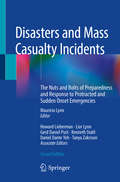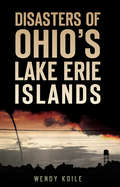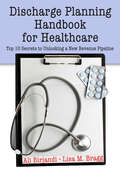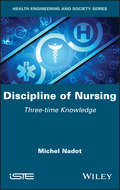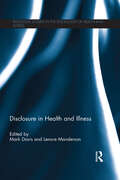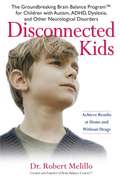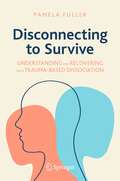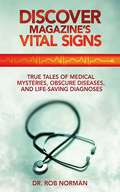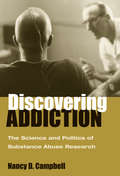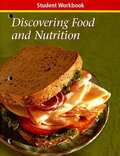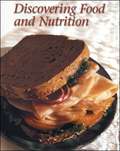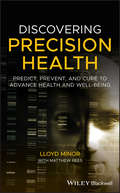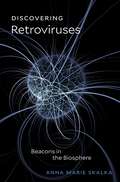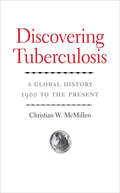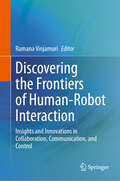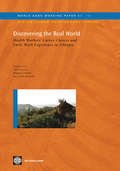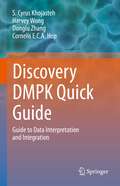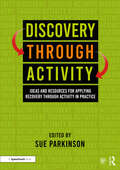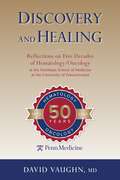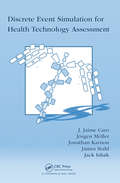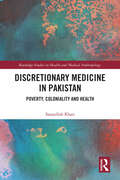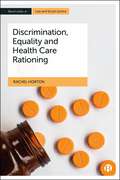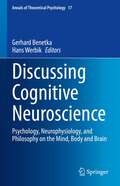- Table View
- List View
Disasters and Mass Casualty Incidents: The Nuts and Bolts of Preparedness and Response to Protracted and Sudden Onset Emergencies
by Mauricio Lynn Howard Lieberman Lior Lynn Gerd Daniel Pust Kenneth Stahl Daniel Dante Yeh Tanya ZakrisonMass Casualty events may occur as a result of natural or human-caused disasters or after an act of terrorism. The planning and response to disasters and catastrophes needs to take into consideration the distinction between progressive and sudden events. Insidious or slowly progressive disasters produce a large number of victims but over a prolonged time period, with different peaks in the severity of patients presenting to the hospital. For example, radiation events will produce a large number of victims who will present days, weeks, months, or years after exposure, depending on the dose of radiation received. The spread of a biological agent or a pandemic will produce an extremely high number of victims who will present to hospitals during days to weeks after the initial event, depending on the agent and progression of symptoms.On the other hand, in a sudden disaster, there is an abrupt surge of victims resulting from an event such as an explosion or a chemical release. After the sarin gas attack in a Tokyo subway in 1995, a total of 5500 victims were injured and required medical attention at local hospitals immediately after the attack. The car bomb that exploded near the American Embassy in Nairobi, Kenya, killed 213 people and simultaneously produced 4044 injured patients, many requiring medical care at local hospitals. The Madrid train bombing in March 2004 produced more than 2000 injured victims in minutes, overwhelming the city’s healthcare facilities. More than 500 injured patients were treated at local hospital after the mass shooting in Las Vegas. Finally, earthquakes may produce a large number of victims in areas in which the medical facilities are partially or completely destroyed. Sudden events bring an immediate operational challenge to community healthcare systems, many of which are already operating at or above capacity.The pre-hospital as well as hospital planning and response to sudden mass casualty incidents (SMCI’s) is extremely challenging and requires a standard and protocol driven approach. Many textbooks have been published on Disaster Medicine; although they may serve as an excellent reference, they do not provide a rapid, practical approach for management of SMCI’s. The first edition of “Mass Casualty Incidents: The Nuts and Bolts of Preparedness and Response for Acute Disasters” dealt exclusively with sudden mass casualty incidents. The second edition will expand its focus and include planning and response for insidious and protracted disasters as well. This new book is designed to provide a practical and operational approach to planning, response and medical management of sudden as well as slow progressive events. The target audience of the second edition will be health care professionals and institutions, as well as allied organizations, which respond to disasters and mass casualty incidents. Parts I and II are essentially the first edition of the book and consist of planning of personnel, logistic support, transport of patients and equipment and response algorithms. These 2 parts will be revised and updated and include lessons learned from major mass shootings that occurred recently in the United States and other parts of the world Part III will describe the planning process for progressive disasters and include response algorithms and checklists.Part IV will handle humanitarian and mental health problems commonly encountered in disaster areas.Part V will deal with team work and communication both critical topics when handling catastrophes and mass casualty incidents. This new book will be a comprehensive tool for healthcare professionals and managers and should perform demonstrably better in sales and downloads. It will be of value at the pre-hospital as well as the hospital level, to plan and respond to the majority of catastrophes and mass casualty incidents.
Disasters of Ohio’s Lake Erie Islands (Disaster)
by Wendy KoileBeautiful and deadly, the Lake Erie islands off the coast of Ohio have seen their fair share of disasters. The Victory Hotel on South Bass Island at Put-in-Bay was once the largest hotel in the nation. But the grand residence was reduced to ashes after a spark quickly became a raging, uncontrollable inferno. Reports of smallpox on Pelee Island resulted in mass hysteria and the quarantine of an entire island. At the Toledo Harbor Lighthouse, one light keeper was frozen in for days with his deceased colleague until he could make a desperate escape. Wendy Koile chronicles the fiercest calamities to shatter the tranquility of these solitary shores.
Discharge Planning Handbook for Healthcare: Top 10 Secrets to Unlocking a New Revenue Pipeline
by Ali Birjandi Lisa M. BraggHidden opportunities to improve profits in the healthcare industry abound in the area of discharge planning. The Discharge Planning Handbook for Healthcare: Top Ten Secrets to Unlocking a New Revenue Pipeline provides innovative new solutions that will show hospital administrators how to turn one of the most antiquated aspects of healthcare into on
Discipline of Nursing: Three-time Knowledge
by Michel NadotNursing students' access to higher education does not mark the beginning of basic scientific research into this discipline, and it is now a struggle for this fact to remain visible. Prejudices, misrepresentations and myths mislead nurses about the origins of nursing knowledge. Discipline of Nursing allows us to compare significant nursing figures: Florence Nightingale (Great Britain) and her equally valuable counterpart Valérie de Gasparin-Boissier (Switzerland). The two distinct training models proposed by these illustrious women have retained their relevance into the 21st Century since as early as 1859. The discipline of nursing seems to be arranged in almost geological layers of knowledge that we can distinguish by studying the traditions of nursing language. This book aims to provide a better understanding of the nature of services provided by nurses worldwide.
Disclosure in Health and Illness
by Mark Davis and Lenore MandersonDisclosure is a frequently used but rarely interrogated concept in health and social welfare. Abuse, disability, sexuality and health status can be ‘disclosed’ to peers and professionals, and on some occasions, disclosure is a requirement and not a choice. This innovative collection examines the new social and political implications of disclosure practices in health and illness. We make our identities and our connections with others by sharing life stories, experiences and innermost desires and are often asked to disclose facts about our lives, bodies and minds, at times with unintended consequences. Yet how and what, why and when people ‘disclose’ – and perceive, question and expose – and in what ways, has rarely received critical analytic attention. The contributors take up these problems by foregrounding the many shades of disclosure: from the secret, through the telling of diagnosis, to the more prosaic sharing of narratives from everyday life. The processes and implications of disclosing are addressed in areas such as: illness trajectories and end-of-life decisions; ethical research practices; medical procedures; and interpersonal relationships. Exploring the idea of disclosure as a moral imperative and a social act, this book offers a diverse range of empirical case studies, social theories and methodological insights to show how dominant and normative understandings of social relationships and their obligations shape our understanding of acts of disclosure, enquiry and exposure. It will be of interest to students and academics with an interest in narrative studies, medical anthropology, bioethics, health psychology, health studies and the sociology of health and illness.
Disconnected Kids: The Groundbreaking Brain Balance Program for Children with Autism, ADHD, Dyslexia, and Other Neurological Disorders
by Robert MelilloBased on years of scientific research and used to successfully treat approximately 1,000 children to date, Dr. Robert Melillo's Brain Balance Program addresses not just the symptoms of what's plaguing our kids but the cause. In Disconnected Kids, Dr. Melillo presents an individualized at-home program that allows readers to assess, address, and even correct their child's neurological disconnects using simple physical, sensory, and academic exercises.
Disconnecting to Survive: Understanding and Recovering from Trauma-based Dissociation (Copernicus Books)
by Pamela FullerThis book provides up-to-date guidance on how to recognize and reduce trauma-based dissociation. Through a therapist-guided approach, readers will increase their awareness of their own experiences of dissociation and develop strategies for reducing these responses, with an overall goal of feeling more connected within themselves and with others. Trauma-based dissociation usually first occurs during a very threatening situation from which there is no physical escape. The dissociative response happens automatically for protection outside of awareness, so the person doesn’t realize what they were doing. This protective response can happen again when other concerning situations occur, and eventually develop into an automatic response to perceived threats. Disconnecting to Survive: Understanding and Recovering from Trauma-based Dissociation is a guide for individuals who experience dissociation or wonder if they do, and for their family, friends, and professionals who want to help them. Several unique features of this book make it valuable as a therapeutic experience for trauma survivors as well as a useful resource for professionals. "Check-ins” throughout the book provide an in-the-moment experience of self-monitoring and pacing while reading. Frequent case examples enhance understanding of the ideas described and validate the experiences of readers who have persevered through traumatic life situations. A section at the end of each chapter provides opportunity to explore how the concepts apply to the reader. Readers also will learn about a three-phase model for determining their present needs and their readiness for different interventions based on their phase of trauma recovery. In addition to physical, emotional, and sexual abuse, other types of interpersonal trauma are delineated, including race-based trauma, religious trauma, medical trauma, emotional neglect, military-related trauma, and mistreatment due to sexual orientation. In addition, a chapter is devoted to each of the important topics of dissociation in children and the relationship between trauma, dissociation, and psychosis.
Discover Magazine's Vital Signs: True Tales of Medical Mysteries, Obscure Diseases, and Life-Saving Diagnoses
by Dr Robert A. Norman"Vital Signs," a popular column featured in Discover Magazine, has long been a favorite of readers, showcasing, each month, fascinating new tales of strange illnesses and diseases that baffle doctors and elude diagnosis. Each tale is true and borders on the unbelievable. It's no wonder that throughout the years the column has become an unofficial textbook for medical students, interns, doctors, and anyone interested in human illness and staying healthy. Now, physician and "Vital Signs" editor Robert Norman has compiled the very best of the series into an intriguing and suspenseful collection for fans and new readers alike. A young woman carries a baby that wasn't her own--and wasn't even a human; Aretha Franklin gives a physician the insight needed to save a life; a modern gynecologist faces an ancient disease. These cases and more, representing a wide variety of unique medical anomalies and life-or-death situations, bring readers to the front lines of the medical fray.Fans of hit medical dramas such as House MD will savor the opportunity to read of the real-life cases that puzzled doctors, the gripping detective work that ensued, and the completely unexpected, often life-saving diagnoses. Discover Magazine's Vital Signs is a glimpse into the exciting work of real medical professionals, told from their perspective, and revealing that anything can happen in medicine. Readers will never look at a "routine check-up" the same again.
Discovering Addiction: The Science and Politics of Substance Abuse Research
by Nancy D. CampbellDiscovering Addiction brings the history of human and animal experimentation in addiction science into the present with a wealth of archival research and dozens of oral-history interviews with addiction researchers. Professor Campbell examines the birth of addiction science---the National Academy of Sciences's project to find a pharmacological fix for narcotics addiction in the late 1930s---and then explores the human and primate experimentation involved in the succeeding studies of the "opium problem," revealing how addiction science became "brain science" by the 1990s. Psychoactive drugs have always had multiple personalities---some cause social problems; others solve them---and the study of these drugs involves similar contradictions. Discovering Addiction enriches discussions of bioethics by exploring controversial topics, including the federal prison research that took place in the 1970s---a still unresolved debate that continues to divide the research community---and the effect of new rules regarding informed consent and the calculus of risk and benefit. This fascinating volume is both an informative history and a thought-provoking guide that asks whether it is possible to differentiate between ethical and unethical research by looking closely at how science is made. Nancy D. Campbell is Associate Professor of Science and Technology Studies at Rensselaer Polytechnic Institute and the author of Using Women: Gender, Drug Policy, and Social Justice. "Compelling and original, lively and engaging---Discovering Addiction opens up new ways of thinking about drug policy as well as the historical discourses of addiction." ---Carol Stabile, University of Wisconsin--Milwaukee Also available: Student Bodies: The Influence of Student Health Services in American Society and Medicine, by Heather Munro Prescott Illness and the Limits of Expression, by Kathlyn Conway White Coat, Clenched Fist: The Political Education of an American Physician, by Fitzhugh Mullan
Discovering Food and Nutrition
by Connie R. SasseThe essential textbook for beginning level food and nutrition courses. "Discovering Food and Nutrition" helps students learn to plan nutritious meals and snacks within limits of time and money, to shop wisely, to work in a kitchen safely and efficiently, and to prepare a variety of foods. "Discovering Food and Nutrition" is an introductory foods program for middle school with short chapters, engaging photos and charts, and a comfortable reading level. It offers middle school students and high school students with special needs the motivation to learn how to become active, engaged students of food preparation, nutrition and consumer skills.
Discovering Food and Nutrition (6th edition)
by Helen KowtalukDiscovering Food and Nutrition is a totally revised textbook for beginning level food and nutrition courses. This illustrated text teaches students to plan nutritious meals, identify the limits of time and money, shop wisely, and work in the kitchen safely.
Discovering Food and Nutrition (7th edition)
by Helen KowtalukThe essential textbook for beginning level food and nutrition courses. Totally revised! This colorfully illustrated text teaches students to plan nutritious meals, identify the limits of time and money, shop wisely, and work in the kitchen safely.
Discovering Precision Health: Predict, Prevent, and Cure to Advance Health and Well-Being
by Lloyd MinorToday we are on the brink of a much-needed transformative moment for health care. The U.S. health care system is designed to be reactive instead of preventive. The result is diagnoses that are too late and outcomes that are far worse than our level of spending should deliver. In recent years, U.S. life expectancy has been declining. Fundamental to realizing better health, and a more effective health care system, is advancing the disruptive thinking that has spawned innovation in Silicon Valley and throughout the world. That's exactly what Stanford Medicine has done by proposing a new vision for health and health care. In Discovering Precision Health, Lloyd Minor and Matthew Rees describe a holistic approach that will set health care on the right track: keep people healthy by preventing disease before it starts and personalize the treatment of individuals precisely, based on their specific profile. With descriptions of the pioneering work undertaken at Stanford Medicine, complemented by fascinating case studies of innovations from entities including the Chan Zuckerberg Biohub, GRAIL, and Impossible Foods, Minor and Rees present a dynamic vision for the future of individual health and health care. You'll see how tools from smartphone technology to genome sequencing to routine blood tests are helping avert illness and promote health. And you'll learn about the promising progress already underway in bringing greater precision to the process of predicting, preventing, and treating a range of conditions, including allergies, mental illness, preterm birth, cancer, stroke, and autism. The book highlights how biomedical advances are dramatically improving our ability to treat and cure complex diseases, while emphasizing the need to devote more attention to social, behavioral, and environmental factors that are often the primary determinants of health. The authors explore thought-provoking topics including: The unlikely role of Google Glass in treating autism How gene editing can advance precision in treating disease What medicine can learn from aviation Discovering Precision Health showcases entirely new ways of thinking about health and health care and can help empower us to lead healthier lives.
Discovering Retroviruses: Beacons in the Biosphere
by Anna Marie SkalkaEight percent of our DNA contains retroviruses that are millions of years old. Anna Marie Skalka explains how our evolving knowledge of these particles has advanced genetic engineering, gene delivery systems, and precision medicine. Retroviruses cause disease but also hold clues to prevention and treatment possibilities that are anything but retro.
Discovering Tuberculosis
by Christian W. McmillenTuberculosis is one of the world's deadliest infectious diseases, killing nearly two million people every year--more now than at any other time in history. While the developed world has nearly forgotten about TB, it continues to wreak havoc across much of the globe. In this interdisciplinary study of global efforts to control TB, Christian McMillen examines the disease's remarkable staying power by offering a probing look at key locations, developments, ideas, and medical successes and failures since 1900. He explores TB and race in east Africa, in South Africa, and on Native American reservations in the first half of the twentieth century, investigates the unsuccessful search for a vaccine, uncovers the origins of drug-resistant tuberculosis in Kenya and elsewhere in the decades following World War II, and details the tragic story of the resurgence of TB in the era of HIV/AIDS. Discovering Tuberculosis explains why controlling TB has been, and continues to be, so difficult.
Discovering the Frontiers of Human-Robot Interaction: Insights and Innovations in Collaboration, Communication, and Control
by Ramana VinjamuriThe field of Human-Robot Interaction (HRI) is rapidly evolving, blurring the lines between human and machine capabilities. Recent advances in computer science, computer vision, artificial intelligence, robotics, brain-computer interfaces, neural engineering, and cognitive science have profoundly transformed HRI. As we stand on the threshold of a new era characterized by increasingly sophisticated human-machine interactions, it becomes imperative to explore the emerging frontiers of this dynamic field. Robots are now entering homes, workplaces, and even battlefields, necessitating a deeper understanding of effective, safe, and ethical human-robot interaction. This book delves into cutting-edge research shaping the future of HRI, representing a collective effort to navigate uncharted territories. Through diverse chapters authored by leading experts, it offers a comprehensive exploration of the latest developments, challenges, and opportunities in HRI. By examining technical, engineering, and methodological challenges, this volume brings together perspectives from researchers, engineers, and designers to provide a comprehensive view of this dynamic field. Aiming to showcase groundbreaking research and spark interdisciplinary dialogue and collaboration, this book is a valuable resource for researchers, engineers, students, and anyone interested in the future of human-robot collaboration. Whether you are a seasoned roboticist, a curious student, or simply interested in future technology, this book offers insights and knowledge to navigate the complex world of human-robot interaction. Join us on this journey of discovery as we navigate the emerging frontiers of human-robot interaction together.
Discovering the Real World: Health Workers' Career Choices and Early Work Experience in Ethiopia
by Magnus Lindelow Pieter Serneels Jose Garcia Montalvo Danila SerraThis paper presents unique evidence on health workers' career choices in Ethiopia. It shows that challenges like health workers' limited willingness to work in rural areas, as well as their likelihood to migrate abroad vary substantially and are correlated with background, motivation, and job satisfaction. Governments in Africa have identified human resources for health as a priority to improve health outcomes. This study is a valuable resource to better understand health worker choices and help toward the design of more effective human resource policies. This working paper was produced as part of the World Bank's Africa Region Health Systems for Outcomes (HSO) Program. The Program, funded by the World Bank, the Government of Norway, the Government of the United Kingdom and the Global Alliance for Vaccines and Immunization (GAVI), focuses on strengthening health systems in Africa to reach the poor and achieve tangible results related to Health, Nutrition and Population. The main pillars and focus of the program center on knowledge and capacity building related to Human Resources for Health, Health Financing, Pharmaceuticals, Governance and Service Delivery, and Infrastructure and ICT.
Discovery DMPK Quick Guide: Guide to Data Interpretation and integration
by Harvey Wong Donglu Zhang Cornelis E.C.A. Hop S. Cyrus KhojastehThis book is intended for a broad readership, in particular, those working or interested in drug discovery coming from various disciplines such as medicinal chemistry, pharmacology, drug metabolism and pharmacokinetics, bioanalysis, clinical sciences, biochemistry, pharmaceutics, and toxicology. It provides, for the first time, a completely integrated look at multiple aspects of ADME sciences (absorption, distribution, metabolism, and excretion) in a summary format that is clear, concise, and self-explanatory. DMPK in Drug Discovery - Guide to Data Interpretation and integration leverages the prior knowledge from the first book that covers the basics of each concept (Drug Metabolism and Pharmacokinetics Quick Guide). This reference book is meant to be used day to day and provides many useful tables (used for data interpretation), figures, and case studies that can facilitate drug discovery. The case studies are intended to be short and relevant to the topic discussed and present another dimension to the discussions.
Discovery Through Activity: Ideas and Resources for Applying Recovery Through Activity in Practice
by Sue ParkinsonDiscovery Through Activity provides a compendium of ideas, resources and practice evaluations that will inspire practitioners to be even more imaginative and to customise their own Recovery Through Activity programmes to meet the specifi c needs of participants. The original Recovery Through Activity handbook offers a flexible programme that is widely used in adult mental health settings. This accompanying and complementary resource shows how the intervention has been extended, adapted and applied service-wide. The resource showcases the work of a growing community of practitioners who have successfully facilitated Recovery Through Activity programmes to provide a forum for people to refl ect on their occupational lives and discuss and practise lifestyle choices that will enable them to improve their health and wellbeing. It includes: • an extended range of flexible ideas and resources to meet the needs of participants in Recovery Through Activity sessions • examples of how to apply Recovery Through Activity in one- to- one sessions and virtual groups • encouragement to adopt Recovery Through Activity across your services with confidence. With contributions illustrating the effective application of Recovery Through Activity in a range of settings and situations, this is a valuable resource for occupational therapists and other practitioners in mental health settings.
Discovery and Healing: Reflections on Five Decades of Hematology/Oncology at the Perelman School of Medicine at the University of Pennsylvania
by David VaughnIn Discovery and Healing: Reflections on Five Decades of Hematology/Oncology at the Perelman School of Medicine at the University of Pennsylvania, David Vaughn describes the history of the Perelman School of Medicine's Division of Hematology/Oncology. Vaughn knows the subject well: he trained in the Division's Hematology/Oncology fellowship program from 1990 -1993 and has been on the faculty of the Division since 1993.Since its founding in 1972, the Division of Hematology/Oncology at the Perelman School of Medicine at the University of Pennsylvania has made important contributions to the fields of blood disorders and cancer medicine. Based largely on his personal experience and extensive interviews with former and present faculty, Vaughn describes the evolution of the Division from a small group of research hematologists to a comprehensive program of fundamental and translational researchers and clinical specialists in benign and malignant hematology and solid tumor oncology. He highlights the importance of leadership as he examines the successes of each of the four Division chiefs: Richard "Buz" Cooper, Sanford Shattil, Stephen Emerson, and Lynn Schuchter. He describes the lasting impact that the Division's first oncologist, John Glick, has had on the Division, the Abramson Cancer Center, and the author himself. He emphasizes the important role that philanthropy has played in the Division's achievements. He concludes the account by reflecting on the Division's experience and call to action as it confronted the COVID-19 pandemic.Both a memoir and a historical account, Vaughn's book demonstrates the good that can be accomplished when an innovative and dedicated medical faculty are committed to discovery and healing.
Discrete Event Simulation for Health Technology Assessment
by J. Jaime Caro Jörgen Möller Jonathan Karnon James Stahl Jack IshakThis is the first book to make all the central concepts of discrete event simulation relevant for health technology assessment. Accessible to beginners, the book requires no prerequisites and describes the concepts with as little jargon as possible. It presents essential concepts, a fully worked out implementation example, approaches to analyze the simulations, the development of the required equations, model verification techniques, and validation. The book also covers various special topics and includes a real case study involving screening strategies for breast cancer surveillance.
Discretionary Medicine in Pakistan: Poverty, Coloniality and Health (Routledge Studies in Health and Medical Anthropology)
by Sanaullah KhanThis book uses the notion of “discretionary medicine” to explore the landscape of contemporary healthcare in Pakistan. It considers how patients frequently experience health interventions as out of touch with the suffering of everyday life and how healthcare provisions are viewed as intrusive, corrupted, and lacking in empathy towards the sick. The study focuses on mental health, acknowledging that the experience of mental illness in Pakistan is increasingly inseparable from conditions of chronic poverty caused directly by deepening inequality. The chapters address the establishment of priorities by the Pakistani healthcare system in conjunction with global disease programs and investigate the misalignments between the priorities of global institutes and local expectations/realities. It is argued that the discretionary nature of medicine is caused by the remnants of colonial-era laws, which link the maintenance of public health with questions of security. This, the author suggests, frequently contributes to forms of care that are riddled with bureaucratic violence. Using a combination of archival and ethnographic research, the book offers a multi-sited and interdisciplinary perspective on healthcare, ranging from care within low-income households and neighborhoods to diasporic communities and state institutions. It will be of interest to scholars and students of medical/psychiatric anthropology, global health, and history of medicine, as well as South Asian and Pakistan studies.
Discrimination of Mobile Supramolecular Chirality: Acylative Molecular Transformations by Organocatalysis (Springer Theses)
by Ayumi ImayoshiThis book proposes a novel concept for molecular recognition. In the field of asymmetric synthesis approaching the mature science, asymmetric discrimination and catalytic synthesis of chiral supramolecules still stand as unsolved problems. The extreme difficulty in asymmetric synthesis of such supramolecules may result from the mobile nature of supramolecular chirality. Here the author shows the first highly enantioselective synthesis of mechanically chiral supramolecules. In the presence of a chiral organocatalyst, a mechanically planar chiral rotaxane was obtained with p erfect enantiopurity (>99% ee) with an excellent selectivity. The dynamic and flexible recognition mode enabled asymmetric synthesis of supramolecules with conformational flexibility and mobility. The recognition mode of the catalyst is a contrast to the traditional static and rigid recognition mode of the typical conventional catalysts. The concept of dynamic molecular recognition will be adopted as a novel concept in a wide range of fields beyond the field of organic chemistry, including material chemistry, biochemistry, and medicinal chemistry.
Discrimination, Equality and Health Care Rationing (Bristol Studies in Law and Social Justice)
by Rachel HortonAvailable open access digitally under CC-BY-NC-ND licence. When deciding who to treat, those engaged in priority-setting and resource allocation in health care need to comply with their obligations under the Equality Act 2010. This book provides an in-depth examination of how anti-discrimination laws intersect with health care rationing in the UK. It critiques how existing legal frameworks apply to resource allocation, questioning whether and when utilitarian principles should be adjusted to incorporate anti-discrimination norms. The author offers detailed cases studies in the contexts of fertility treatment, public health and intensive care, highlighting practical implications and real-world challenges. This is a timely legal analysis, providing crucial policy insights in the wake of recent global health crises.
Discussing Cognitive Neuroscience: Psychology, Neurophysiology, and Philosophy on the Mind, Body and Brain (Annals of Theoretical Psychology #17)
by Gerhard Benetka Hans WerbikThe sciences philosophy, psychology and neuroscience share the basis that all refer to the human being. Therefore, an interdisciplinary collaboration would be desirable. The exchange of criticism is an essential requirement for interdisciplinary collaboration. Criticism must be heard and – if possible – considered. Indeed, criticism can be valid or unwarranted. However, whether criticism is unwarranted can only emerge from discussion and conversation. In the discussion of cognitive neuroscience, some criticism can easily be considered (such as the mereological fallacy that represents that talking about the person is substituted with talking bout the brain). Another issue for an interdisciplinary discussion of cognitive neuroscience is the interpretation of the readiness potential including re-considering Benjamin Libet’s classic experiments. Additionally, a critical discussion on cognitive neuroscience must address ethical questions, such as the possibility of the abuse of neuroscientific insight.
